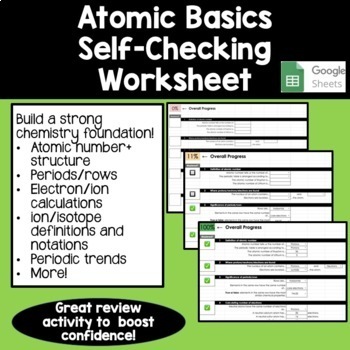Atomic Basics: Atomic Number + Structure, Periods + Groups, Ions + Isotopes
- Google Drive™ folder
- Excel Spreadsheets

Description
Atomic number, protons/neutrons/electrons locations, periods/rows, electron/ion calculations, mass formula, locating valence electrons, ion/isotope definitions and notations, polarity, periodic trends (Atomic radius, reactivity, ionization energy), delocalized electrons, key groups, metals/nonmetals/metalloids, significance of valence electrons + significance of groups/families/columns, and noble gas envy are topics.
Please click on the preview to see the ENTIRE product.
This is probably the easiest worksheet you will ever hand out to students--that is the goal!
How does the self grading work?
This spreadsheet is completely self-checking, and students will get a green emoji checkmark when they have completely mastered a section/topic. Students will NOT get a green emoji checkmark if they have even one incorrect answer in a section. Their "overall progress" will go up as they master sections.
Is this editable?
Sort of! If there is a question you would like to remove, you need to delete the whole section. The reason for this requires a longer coding explanation, so just take my word for it :). For example, many classes haven't covered polarity in the first unit, so those sections may make sense to remove.
Please follow my store for more science + Google sheets resources. Happy teaching!




